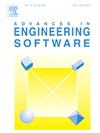Prediction and analysis of temperature recovery after arch closure grouting of Baihetan Arch Dam
IF 5.7
2区 工程技术
Q2 COMPUTER SCIENCE, INTERDISCIPLINARY APPLICATIONS
引用次数: 0
Abstract
Arch closure grouting is an essential procedure for attaining structural completion during the construction of a concrete arch dam. After the closure, due to the continuous heat emission from cement hydration, the internal temperature of concrete rises rapidly, which affects stress distribution and structural stability. In order to accurately predict the temperature evolution of concrete pouring blocks after arch closure, this paper conducted a comparative study using neural networks and finite element methods. First, a hybrid model, CNN-BiLSTM, was constructed. This model integrates a Convolutional Neural Network (CNN) and a Bidirectional Long Short-Term Memory (BiLSTM). The Weighted Mean of Vectors algorithm (INFO) was then introduced to optimize the model parameters. The temperature variation trend of concrete pouring blocks after arch closure was predicted using this approach. Simultaneously, considering the factors such as external temperature, cooling water, adiabatic temperature rise and concrete age, a three-dimensional finite element model of concrete pouring blocks was established to simulate the temperature field distribution of concrete. The comparison results indicate that both methods can achieve the prediction accuracy required by the project (with an error of less than 2 °C). Among them, the finite element simulation performs better in terms of stability (with a difference of less than 1 °C from the measured value). At the same time, the INFO-CNN-BiLSTM model exhibits significant temperature fluctuations during certain periods and demonstrates insufficient generalization ability. However, it offers the advantage of high computational efficiency.
白鹤滩拱坝闭拱注浆后温度恢复预测与分析
在混凝土拱坝施工中,闭拱灌浆是保证结构完工的重要工序。闭合后,由于水泥水化持续放热,混凝土内部温度迅速升高,影响应力分布和结构稳定性。为了准确预测混凝土浇筑块合拱后的温度演变,本文采用神经网络和有限元方法进行了对比研究。首先,构建了CNN-BiLSTM混合模型。该模型集成了卷积神经网络(CNN)和双向长短期记忆(BiLSTM)。然后引入向量加权平均算法(INFO)对模型参数进行优化。利用该方法预测了混凝土浇筑块合拱后的温度变化趋势。同时,考虑外部温度、冷却水、绝热温升和混凝土龄期等因素,建立混凝土浇筑块三维有限元模型,模拟混凝土温度场分布。对比结果表明,两种方法均能达到工程要求的预测精度(误差小于2°C)。其中,有限元模拟在稳定性方面表现较好(与实测值相差小于1℃)。同时,INFO-CNN-BiLSTM模型在特定时期温度波动较大,泛化能力不足。然而,它具有计算效率高的优点。
本文章由计算机程序翻译,如有差异,请以英文原文为准。
求助全文
约1分钟内获得全文
求助全文
来源期刊

Advances in Engineering Software
工程技术-计算机:跨学科应用
CiteScore
7.70
自引率
4.20%
发文量
169
审稿时长
37 days
期刊介绍:
The objective of this journal is to communicate recent and projected advances in computer-based engineering techniques. The fields covered include mechanical, aerospace, civil and environmental engineering, with an emphasis on research and development leading to practical problem-solving.
The scope of the journal includes:
• Innovative computational strategies and numerical algorithms for large-scale engineering problems
• Analysis and simulation techniques and systems
• Model and mesh generation
• Control of the accuracy, stability and efficiency of computational process
• Exploitation of new computing environments (eg distributed hetergeneous and collaborative computing)
• Advanced visualization techniques, virtual environments and prototyping
• Applications of AI, knowledge-based systems, computational intelligence, including fuzzy logic, neural networks and evolutionary computations
• Application of object-oriented technology to engineering problems
• Intelligent human computer interfaces
• Design automation, multidisciplinary design and optimization
• CAD, CAE and integrated process and product development systems
• Quality and reliability.
 求助内容:
求助内容: 应助结果提醒方式:
应助结果提醒方式:


